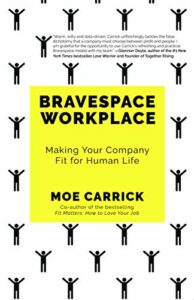Make Work Great
Leaders recognize that organizations are great because of the people working in them. Knowing that people make or break a company is one reason leaders are constantly trying to improve company culture.
Moe Carrick’s new book, Bravespace Workplace: Making Your Company Fit for Human Life, recognizes the importance of people so much that the dedication at the very front of it is “dedicated to workers everywhere. You are the heart of it all, and it’s what you do every day that makes your company great.” How very true that is, and how incredible for Moe to recognize it even before page one.
“If only my manager thought that way,” you may be thinking or even, “Would it be too obvious for me to buy a copy for my manager?”
Moe addresses some important issues as she advocates for people, for culture development, and for thriving organizations in the midst of rapid change. I reached out to her to talk about her work.
Make it a Bravespace
What does a bravespace workspace look like?
Most simply, I define a bravespace workplace as one where people can show up as they are, both perfect and flawed, and do great things together. Bravespace workplaces activate, enliven, and tenderly support the complex humans that we are so that we can bring all of ourselves to work every day. This means that an organization designs itself, trains its people leaders, and runs day-to-day processes so that the people who work there (any company’s greatest asset!) can bring their highest and best skills to work every day. People sometimes over-simplify what I am saying as “a workplace where people are happy” but let’s face it, an ice cream cone can make me happy! Creating the kind of workplace that is actually fit for human life goes way beyond mere happiness.
You spend some time talking about AI, machines, robots, and technology. What are a few things people should know when contemplating the world of work in the future?
I reference this awesome Isaac Asimov quote in the Chapter, AI, Machines, Robots, Oh My! and that is, “In a properly automated and educated world, then, machines may prove to be the main humanizing influence. It may be that machines do all the work that makes life possible and human beings will do all the things that make life pleasant and worthwhile.” Isn’t that a great sentiment?
Machines, big data, automation, etc. are not going anywhere; in fact, they continue to proliferate in our daily lives at home and work. But there are things that technology simply cannot do…really any job requiring human connection, inspiration, collaboration, leadership, trust, creativity, and intuition. In bravespace workplaces of tomorrow, people won’t simply be replaced with machines; instead robots, AI, and technology will be leveraged to activate the best possible decision-making and partnerships of the people who work in them. We humans need to work for a whole host of reasons: to give our lives purpose, to grow and learn, to make our lives work, to connect with other people, to co-create, to build, and more. Machines, AI, robots, and big data can and should activate us to work in those unique areas that only we can contribute, and to leave everything else to machines, AI and robots.
The Toxic Workplace
Contrast this with a toxic workplace. What immediately signals that this is not a healthy environment to you?
There are a whole host of things that tip me off to a toxic workplace. At the center is a leader who is bad for people. Period. We experience work, and our organization, primarily through our immediate boss. This is the first thing I look for when I am brought in to a company: how is leadership showing up? In addition, I pay attention to the boundaries in place at the company around time–do they have any? Do leaders model healthy boundaries on their lives while also being flexible? Is there time to think? I also look for inclusion, which transcends a basic focus on having a diverse workforce into really activating the best that the differences between people bring to the work. When inclusion exists, we see more health, more creativity, more healthy risks, and more trust. And finally, I tune in to whether people can tell each other the hard things. Surface harmony and politeness are a harbinger usually for backchanneling, gossip, and a failure to give feedback straight up.
You go so far as to say, “most workplaces are unfit for human life.” Tell us why that is. How did we get here?
In my mind, it has been a slow but steady process. Decades of business ethics that have kept emotions out of the workplace have resulted in feelings leaking out in inappropriate (and often devastating) ways which has led to stress-related illnesses and absenteeism, as well as under-engaged employees bring mere fractions of their best work. In addition, I think our relentless focus on profit as the only North Star for business has resulted in a diminishment of value on other essential dimensions of organizational health such as employee well-being, team cohesion, social and environmental impact and more. Somewhere along the line we have degraded our thinking about people as commodities it seems, rather than the unique, complex (and messy) humans that we are. It is not too late to change, though, which requires us to go beyond the surface elements of workplace health such as perks and compensation wars.
 What are some characteristics of the bravespace workplace leader?
What are some characteristics of the bravespace workplace leader?
This is easy! First and foremost, they are real. Period. End. Stop. But this dimension of leadership is actually the hardest ever because for decades we have studied and described leadership as being iconically heroic, which is definitely not real in the very human ways that matter. For me, this means that bravespace workplace leaders walk their talk and model what they say they value. They name the ugly, scary, and hard rather than pretending it doesn’t exist. They go first, even when there are no guarantees. These leaders remember that “it all made sense at the time,” and they don’t wallow in regret or failure. They use self-compassion as evidence of the real empathy they bring to everyone they work with. And finally, these leaders own their sh**. Most of us come to work with one thing in mind: we want to do a good job and be seen as worthy. It is up to leaders to manifest this feeling in employees. No pressure, right?
7 Needs Work Should Fulfill
1: To meet our basic requirements
2: To contribute
3: To be seen
4: To connect
5: To learn
6: To feel supported
7: To make our lives work
Find Meaning and Context
What do you say to help people find meaning and context in their work?
In the book I identify seven things that we all need from work. Two of these center on meaning and context. The first is our essential need to contribute, which I define as doing something that matters to someone. This doesn’t have to be a high and mighty social mission or cause. It can be as simple as knowing how the job we do today matters to someone somewhere. The second is to feel supported, which I define as being able to be brave even when there are risks (duh, always!). It is in this support that we find the room to innovate, create, design, provoke, challenge, and grow. What my research has discovered is that we can find meaning in an almost unlimited real WHY of whatever it is that we are doing, and then having someone who will notice when we do it or do it well.
For more information, see Bravespace Workplace: Making Your Company Fit for Human Life.

